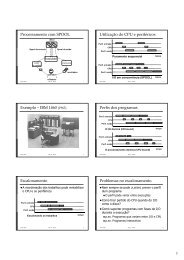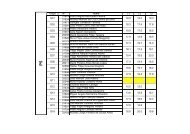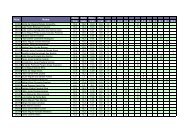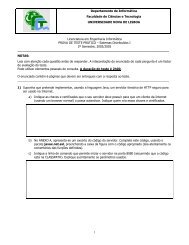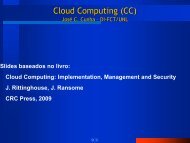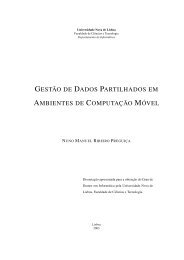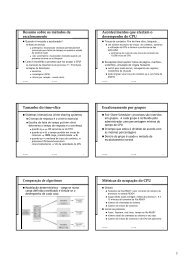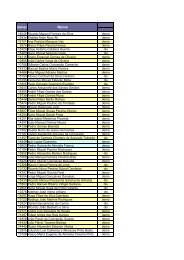Dissertaç ˜ao de Mestrado Mestrado em Engenharia Informática Jo ...
Dissertaç ˜ao de Mestrado Mestrado em Engenharia Informática Jo ...
Dissertaç ˜ao de Mestrado Mestrado em Engenharia Informática Jo ...
Create successful ePaper yourself
Turn your PDF publications into a flip-book with our unique Google optimized e-Paper software.
3. AN APPLICATION RECONFIGURATION FRAMEWORK 3.2. Automatic Application Configuration<br />
parsers, and continue from the same state later.<br />
10. The user must be able to manually <strong>de</strong>lete parsers from the parser repository.<br />
Description: The user must be able to manually <strong>de</strong>lete parsers from the parser repository<br />
so that the user may intervene if the parser repository becomes to big, or if a certain parser<br />
becomes obsolete.<br />
3.2 Automatic Application Configuration<br />
Having i<strong>de</strong>ntified the requir<strong>em</strong>ents for the tool, it is now possible to tackle a possible solution<br />
for the probl<strong>em</strong>. This section presents a framework which is the solution proposal for the<br />
automatic configuration of applications.<br />
The application configuration files are read by the tool, which parses th<strong>em</strong> in or<strong>de</strong>r to con-<br />
vert their syntax from the original to a generic, application-in<strong>de</strong>pen<strong>de</strong>nt, one. This allows for<br />
the configuration files to be manipulated and altered in the same way, for any application,<br />
through an agent which recognizes the generic syntax.<br />
Being in generic syntax, the file can be efficiently modified by an agent which operates on<br />
that kind of syntax, such as an automated script. Ensuing the file modification, the tool is<br />
responsible to do the inverse conversion, back to the file original form. Once the file has been<br />
converted to the generic syntax, the characteristics of the original syntax have been aprehen<strong>de</strong>d<br />
and can be used to reconvert the file back to its original syntax.<br />
The configuration process (Figure 3.1) can be divi<strong>de</strong>d into three main stages:<br />
1. Configuration file extraction;<br />
2. Original to generic syntax conversion;<br />
3. File modification;<br />
4. Generic to original syntax conversion.<br />
The second stage is accomplished through an Original to Generic syntax Converter (OGC)<br />
and the fourth by a Generic to Original syntax Converter (GOC). This dissertation points ways<br />
in which OGC and GOC might evolve. The first and third stages are not on the original work<br />
scope and therefore are not tackled in <strong>de</strong>tail. Nevertheless, Section 3.5 approaches the file<br />
modification area superficially, hinting at some possible ways of <strong>de</strong>aling with the subject and<br />
i<strong>de</strong>ntifying possible operational constraints.<br />
3.3 Original to Generic syntax Converter<br />
The Original to Generic syntax Converter (OGC) is structured like a three-tier<br />
architecture [Ram00]. The three-tier architecture consists of a software <strong>de</strong>sign pattern which<br />
24



